Norway Lutheran church cemetery
Introduction
Text-to-speech Audio
Muskego, a Native American word for cranberry bogs, is an apt description of the surrounding lowland which the original Norwegians settled on. Standing on a large glacial kame which rises as a hilly knob south of Wind Lake, you can see for miles around. This scenic and serene spot was the perfect choice to locate a church. As the church was the center of 19th century community life, the “Old Muskego” state historical marker greets visitors at the base of “Indian Hill.” Walk up the hill and pass under the Norway cemetery arch. A Norwegian flag flies nearby, making you feel a little like you have passed over into Valhalla.
The most labor-intensive task for farmers at that time was transporting harvested crops to market by ox team and wagon. For two or three years after immigrating, pioneers were subsistence farming, raising crops for their own families. At the beginning, they were clearing land and breaking a couple acres each year. Later, they could sell their surplus at market.
Muskego-Norway was closer to a shipping port than any other Norwegian-American settlement of the 1840s. The relatively short twenty-five-mile distance to the port of Milwaukee could be covered in one or two days. This made it easier for Muskego farmers to sell their harvest, then for those farther away. It was also easier for immigrants to travel to Muskego-Norway. Friends and relatives took in newcomers, who crowded into 16x18 foot log cabins. Many slept in the loft, others slept in makeshift lean-tos or barns, and others bedded down in hay mounds. As they arrived, some unwittingly brought highly infectious cholera, which ended up decimating the colony.
Before the cholera epidemics began, Tollef Bache hired Claus Lauritz Clausen to educate the community’s children. A Dane, Clausen traveled throughout Scandinavia, studying for the first ten years of his adult life. Søren Bache returned home in 1843 to provide reports to his father about the colony and refill the cashbox with more silver. Clausen, his bride Martha and Søren Bache returned to America the following year with another group of colonists. They traveled in first class cabins and enjoyed meal service, while the other colonists were crammed below deck. Not long after arriving, the ambitious Clausen determined that Muskego-Norway needed a preacher more than they needed a teacher and he worked to create that job for himself. As is often the case, religion drove a wedge through the community. Clausen rallied newcomers to sign a petition calling him to be their Lutheran minister, even though he had little formal theological training. Bache and Heg had established the community specifically so their countrymen could worship as Haugeans. They resented Clausen’s efforts to dictate the religious tone of the community. This rift, along with the terrible reality of diseases that ravaged the settlement, eventually caused Clausen to move on to the Rock Prairie (Luther Valley) Norwegian settlement in Rock County.
Images
"Old Muskego" Wisconsin Historical Marker
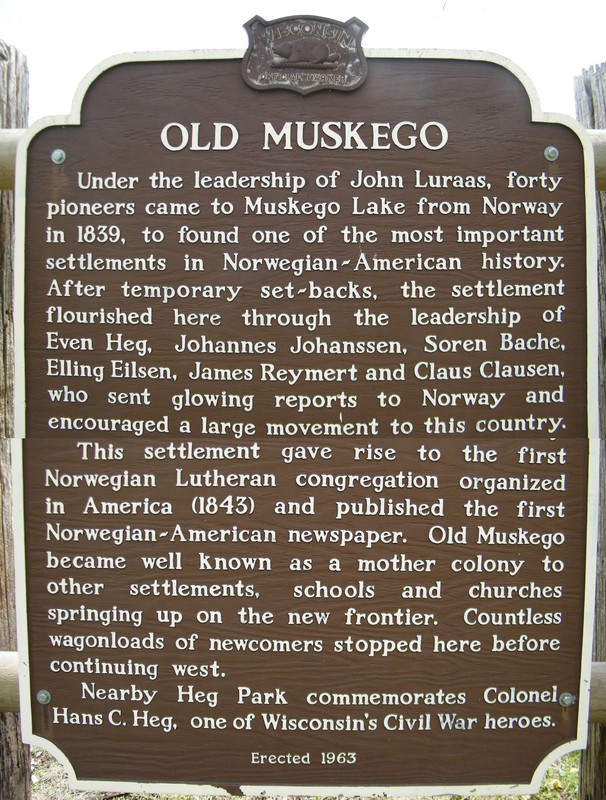
Arched entrance to Norway cemetery
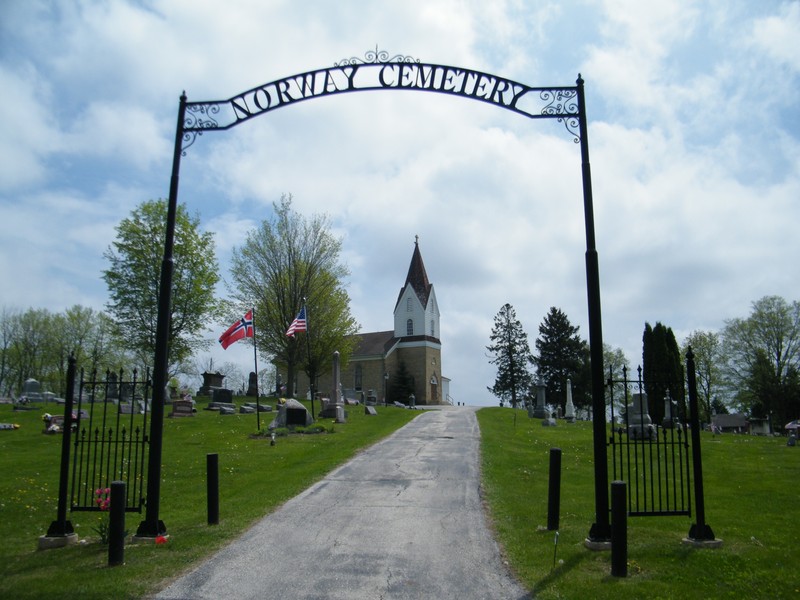
Memorial to epidemic victims of early colony. Placed here by the Norway (town of) Historical Society in the 1990s.

Even and Sigrid Heg were leading members of the early Muskego-Norway community. Obelisk in back is a Col. Hans Heg gravestone which replaced old broken tombstone in 1925.
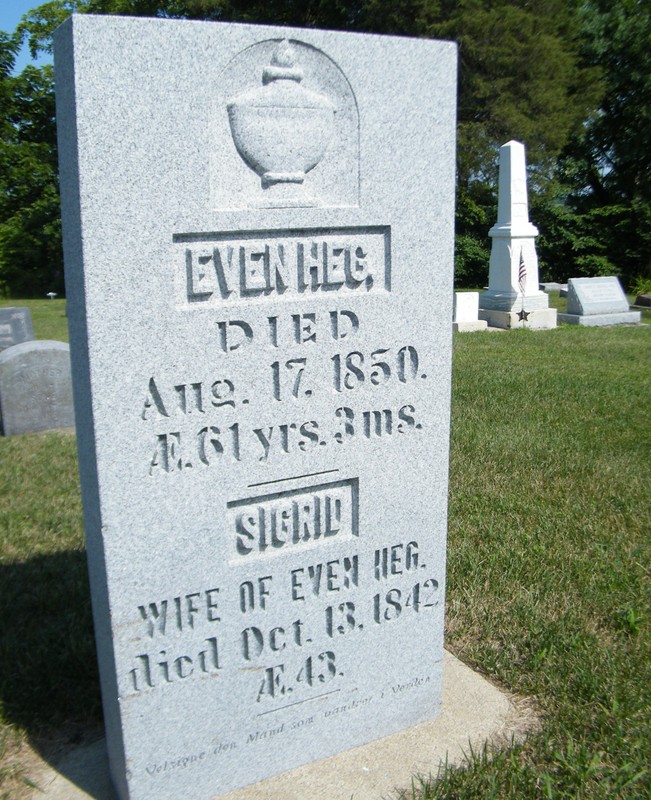
Text on Hans Christian Heg's tombstone
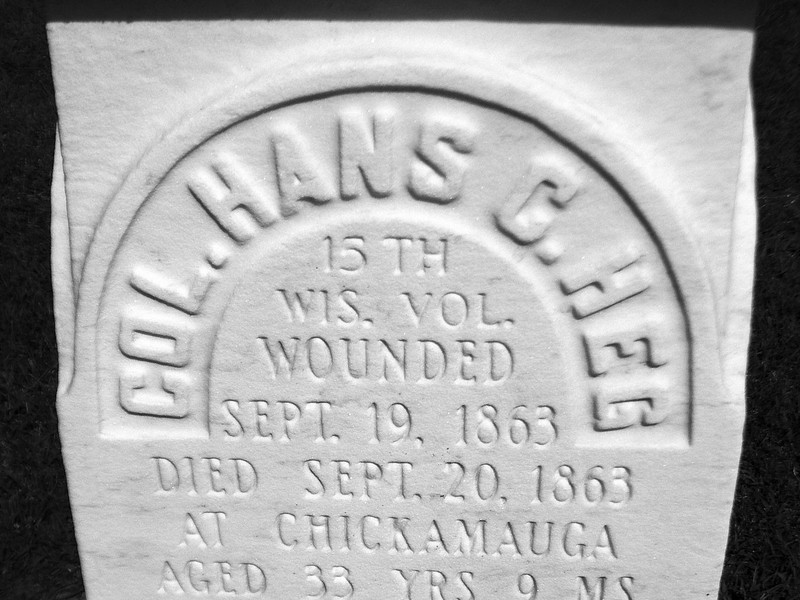
This altar served Norway Lutheran Church since 1870 and is still used for special events.
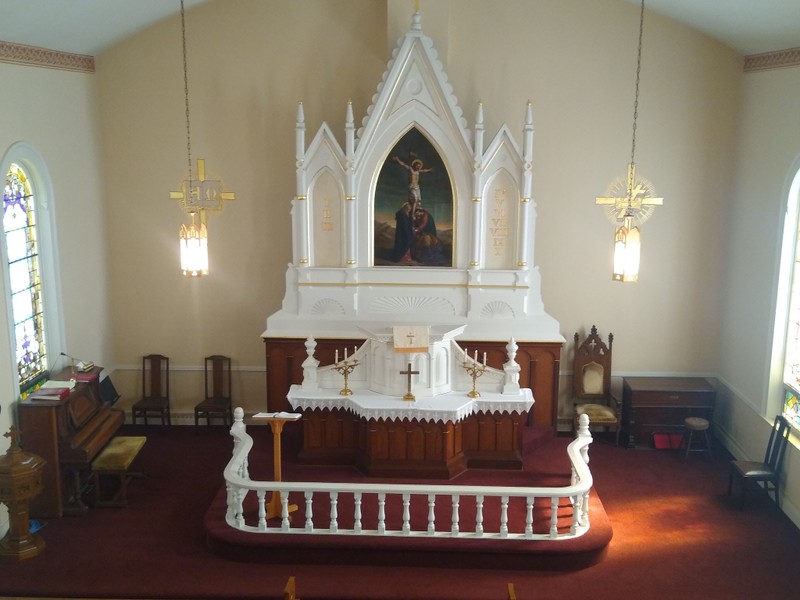
Church museum in basement of the "old church on the hill" includes pioneer pastor Claus Clausen's personal effects.
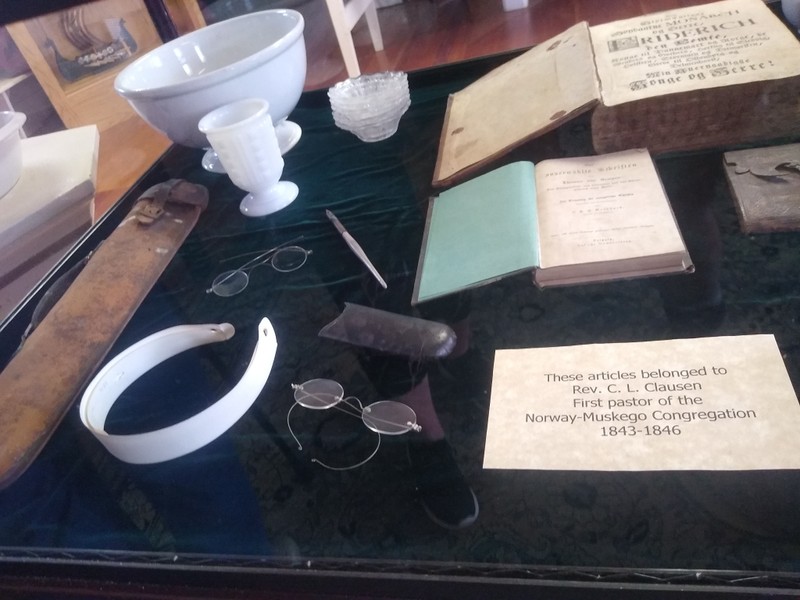
Backstory and Context
Text-to-speech Audio
Clausen was one of many who fled to escape Muskego’s grim reaper, but not before he officiated at the burials of hundreds of Norwegian-Wisconsinites who were struck down by malaria. In one month at the peak of the epidemic, over a hundred men, women and children died. They were buried in a mass grave in the Norway Lutheran Church cemetery, with Clausen offering prayers. A grey granite stone with an affixed plaque symbolizes the burial site.
John Nelson Luraas said:
“The settlement grew and became a stopping place for many later immigrants who would remain in Muskego a year or two before going out to other settlements in Wisconsin. But in 1849, 1850 and 1852, cholera visited the settlement and caused such a mortality that the location came into disrepute. Most of those who were spared emigrated to other settlements.”[1]
John Evenson Molee wrote:
“1849 was the year of the Asiatic cholera in the United States and Europe. It was the awfulest summer I experienced in my life. When the epidemic struck our settlement, there were, at one time, only seven families all well, so that they could get away to help their neighbors. Three or four persons died every day. Hans Tveito and myself had all we could do, to carry the dead out of the houses and haul them to the grave with our oxen, while others dug the graves. No ceremony took place. We simply rolled a white sheet around the dead, unwashed and unshaven. Then we placed him or her into a rough board box, unplaned and unpainted, and hauled them to a spot selected for a graveyard, called ‘the Indian hill’ where we laid them to rest. It was the best we could do, God knows. We cared for them the best we could, while living, but when dead, they did not need more care.”[2]
One of the heroes of the cholera epidemic was a Norwegian convict named Hansen. In the late 1830’s he was one of Norway’s most notorious burglars. He reformed while imprisoned and was paroled under the condition that he leave Norway. According to Rev. H.G. Stub, Hansen found his way to Muskego-Norway:
“He had but one mission in life – to do good. For a while, he carried the mail between Muskego and Milwaukee . . . mainly on foot both ways. He had a small shop where he made and sold tinware. But in reality he was Muskego’s nurse. As such he was very much needed. During the last epidemic there were up to fifty patients at one time in the so-called hospital. Like a comforting angel Hansen went from one patient to another with temporal and spiritual help. Finally the powerful Hansen also succumbed, but not to cholera . . . He was taken sick with typhoid . . . After a long and hard sickness he died . . . The Hansen funeral was the largest funeral held in Muskego up to that time.”[3]
Colonel Heg, his parents and many of the settlers from the old country are buried in the church’s cemetery. Even and Sigrid Heg are buried at the back of the cemetery on the far side of the church. The white pillar in the distance is Colonel Hans Heg’s gravesite.
Cite This Entry
Palecek, Mike. "Norway Lutheran church cemetery." Clio: Your Guide to History. July 18, 2024. Accessed April 16, 2025. https://theclio.com/tour/2699/5
Sources
[1] Anderson, Rasmus. The First Chapter of Norwegian Immigration (1831-1840) its Causes and Results (Madison WI, 1895), page 294
[2] ibid, page 321
[3] Rønning, Nils Nilsen. The Saga of Old Muskego (Minneapolis MN, 1943), pages 45-46
Palecek, Mike. The first Norwegian settlements in America : excerpted from The first chapter of Norwegian immigration (1821-1840) : its causes and results by Rasmus Anderson, 1895 (Racine WI, 2019), page 182-184
Palecek, Mike
Palecek, Mike
Palecek, Mike
Palecek, Mike
Palecek, Mike
Palecek, Mike

